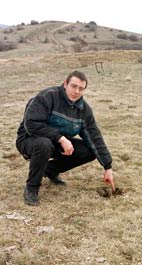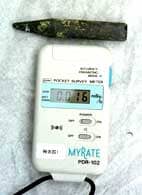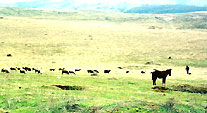SpecialReports NATO bombing Yugoslavia southern serbia Scientists gravely concerned about health effects DU near private homes
Jul. 7, 2000
"Most penetrators in the earth, impossible to collect them all."
From, Nis, the second largest city in Yugoslavia, my guide and interpreter Nikola Bozinovic (25) and I head by car to Vranje, a city of 65,000. We drive 115 kilometers (72 miles) south on the main road to Macedonia. The National Health Institute is in the heart of the city. We were ushered to a second floor conference room where Miroslav Simic (32), in charge of the Physics Department and directly involved in the DU survey, began his explanation.
"At least 3 or 4,000 DU shells were fired in southern Serbia." The institute has been unable to survey dangerous places near the Kosovo border or in areas accessible only by jeep, so as he points out, "The actual number could be far greater."
Field full of holes
After receiving a video presentation of the institute's survey conducted by Simic and his team, we visited Rerjan, a village where DU munitions were actually used. An army colonel (56) rode with us "for safety."
Rerjan is about 20 kilometers (13 miles) southwest from Vranje. It is farming village with a population of a few hundred. It is located in Serbia, yet Muslim Albanians live there peacefully. It is one of the few "coexistence areas" that are so rare these days.
We stopped the car on a hill where about 40,000 Yugoslavian soldiers were encamped during the war. About five kilometers (3 miles) on the other side of the hill, from which there was a good view, we could see the border with Macedonia.
"Look. See all these holes? They're made by DU penetrators." Getting out of the car, we walked over the field. The holes, about 10 centimeters (4 inches) in diameter, were everywhere. Fired from A10 fighter planes equipped with 7-chambered machine guns capable of firing 30mm rounds at more than 1000 rounds per minute, the penetrators that failed to strike metal (tanks, etc.) went straight into the ground, buried 1.2 to 1.5 meters deep.
"We had lots of dummy tanks made of wood all around, right? The pilots thought they were real tanks and attacked them ferociously. Some of the rounds fell very close to private homes," said Simic. Some of the DU penetrators from this area were removed by the military, placed in special shielded containers and stored in the basement of the Institute.
"We don't really know how many DU penetrators actually hit the tanks or trucks they were aimed at. Those that did were vaporized and the particles scattered into the air. It is certainly true that the majority are buried in the earth. However, it would be impossible to go around removing them all." says Simic.
Involving doctors in the investigation
After returning to Nis, I met with Golan Manic (41) =pictured=, who has been traveling around surveying soil radiation levels in southern Serbia where the DU munitions were used. He is director of the Radiation Department at the Institute of Occupational Health. He opened his notebook and began to explain what he had found after analyzing about 500 samples.
"In soil directly next to a buried DU penetrator we found a maximum of 235,000 Becquerels of U-238 per kilogram. This figure refers to the number of atoms decaying per second, and this level of radiation is similar to that found in areas contaminated by the Chernobyl nuclear power accident."
According to Manic, soil with large amounts of buried DU can be expected to affect the crops grown in it, the livestock that feed on those crops, and the underground water. Clearly we need to consider the impact on human beings as the radiation comes up through the food chain.
"We intend to work with doctors to watch this impact very carefully. Nis and the capital city Beograd suffered tremendous damage from bombs and missiles, but luckily they haven't found any radiation," says Manic.
The institute's greatest concern is the impact on Kosovo, where the most DU munitions were used. However, given the present conflict situation, "We can't just go over to Kosovo and conduct a survey." Manic's expression is grim.
(Originally published on July 7, 2000)











